POLICING: UK Law, Police Powers, and Contingency Management
VerifiedAdded on 2020/04/13
|16
|4080
|401
Homework Assignment
AI Summary
This assignment delves into the core principles of UK policing, outlining the relevant regulations and legislation, including the Police and Criminal Evidence Act 1984 (PACE) and the Human Rights Act 1988. It examines the powers of police officers, focusing on lawful arrest procedures under PACE, the conditions for detention, and pre-charge bail. The assignment also explores the use of out-of-court disposals and other disposal options. Furthermore, it addresses the contingencies that may arise during the processing of suspects, such as the use of physical force and potentially violent incidents, emphasizing the importance of training and safety measures, including the prevention of positional asphyxia, and the role of the Criminal Justice and Immigration Act 2008. The assignment underscores the importance of ethical conduct, accountability, and the safeguarding of protected characteristics within the police force.

Running head: POLICING
Policing
Name of the Student
Name of the University
Author Note
Policing
Name of the Student
Name of the University
Author Note
Paraphrase This Document
Need a fresh take? Get an instant paraphrase of this document with our AI Paraphraser
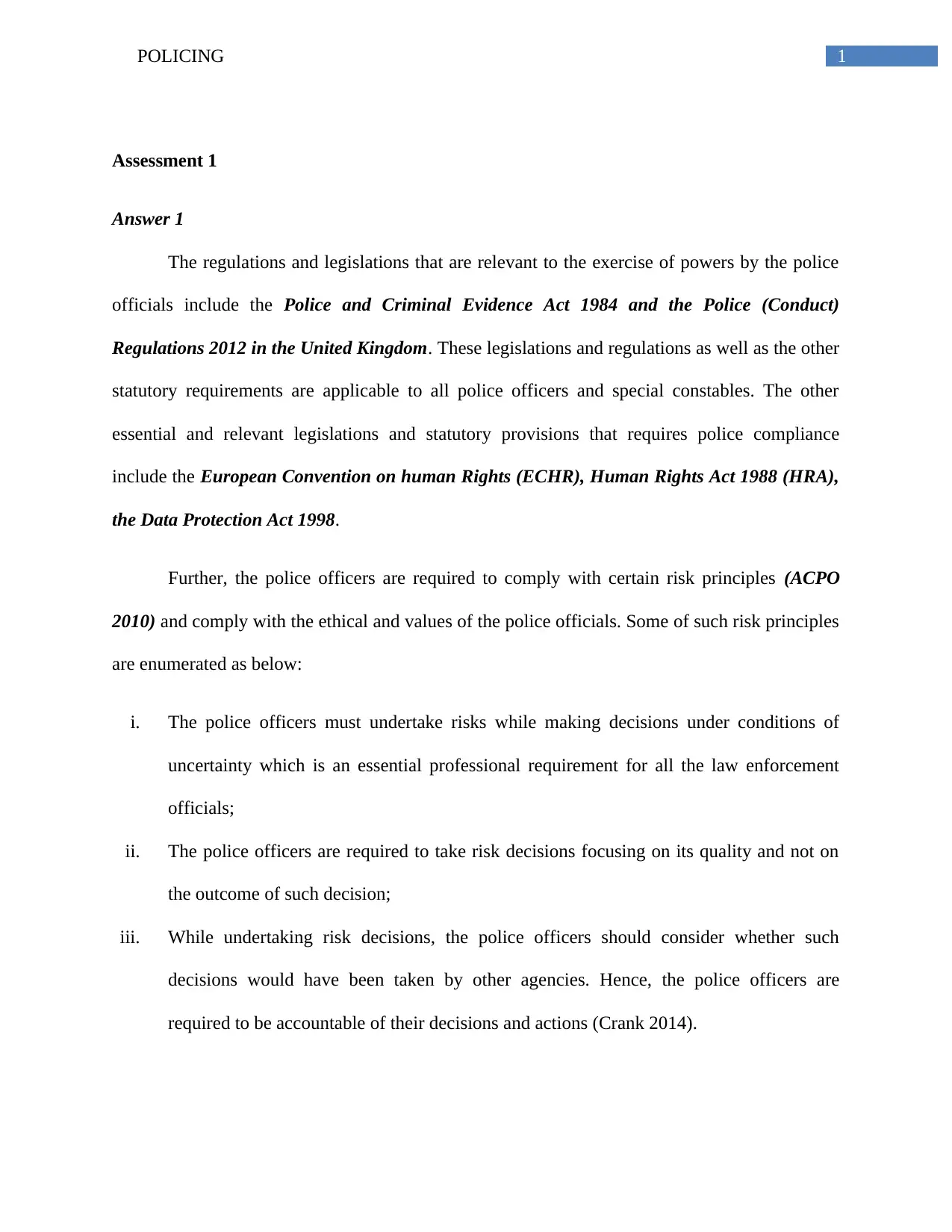
1POLICING
Assessment 1
Answer 1
The regulations and legislations that are relevant to the exercise of powers by the police
officials include the Police and Criminal Evidence Act 1984 and the Police (Conduct)
Regulations 2012 in the United Kingdom. These legislations and regulations as well as the other
statutory requirements are applicable to all police officers and special constables. The other
essential and relevant legislations and statutory provisions that requires police compliance
include the European Convention on human Rights (ECHR), Human Rights Act 1988 (HRA),
the Data Protection Act 1998.
Further, the police officers are required to comply with certain risk principles (ACPO
2010) and comply with the ethical and values of the police officials. Some of such risk principles
are enumerated as below:
i. The police officers must undertake risks while making decisions under conditions of
uncertainty which is an essential professional requirement for all the law enforcement
officials;
ii. The police officers are required to take risk decisions focusing on its quality and not on
the outcome of such decision;
iii. While undertaking risk decisions, the police officers should consider whether such
decisions would have been taken by other agencies. Hence, the police officers are
required to be accountable of their decisions and actions (Crank 2014).
Assessment 1
Answer 1
The regulations and legislations that are relevant to the exercise of powers by the police
officials include the Police and Criminal Evidence Act 1984 and the Police (Conduct)
Regulations 2012 in the United Kingdom. These legislations and regulations as well as the other
statutory requirements are applicable to all police officers and special constables. The other
essential and relevant legislations and statutory provisions that requires police compliance
include the European Convention on human Rights (ECHR), Human Rights Act 1988 (HRA),
the Data Protection Act 1998.
Further, the police officers are required to comply with certain risk principles (ACPO
2010) and comply with the ethical and values of the police officials. Some of such risk principles
are enumerated as below:
i. The police officers must undertake risks while making decisions under conditions of
uncertainty which is an essential professional requirement for all the law enforcement
officials;
ii. The police officers are required to take risk decisions focusing on its quality and not on
the outcome of such decision;
iii. While undertaking risk decisions, the police officers should consider whether such
decisions would have been taken by other agencies. Hence, the police officers are
required to be accountable of their decisions and actions (Crank 2014).
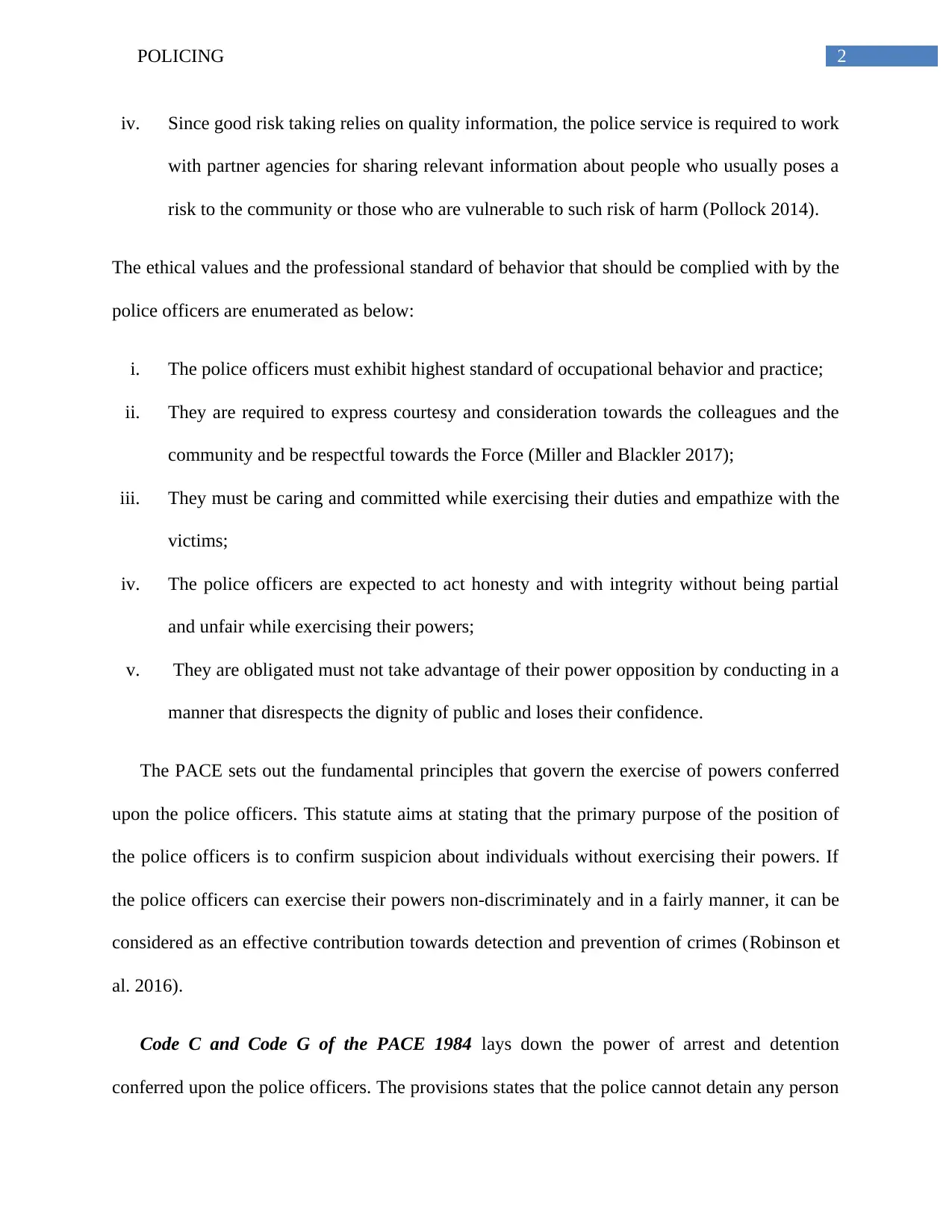
2POLICING
iv. Since good risk taking relies on quality information, the police service is required to work
with partner agencies for sharing relevant information about people who usually poses a
risk to the community or those who are vulnerable to such risk of harm (Pollock 2014).
The ethical values and the professional standard of behavior that should be complied with by the
police officers are enumerated as below:
i. The police officers must exhibit highest standard of occupational behavior and practice;
ii. They are required to express courtesy and consideration towards the colleagues and the
community and be respectful towards the Force (Miller and Blackler 2017);
iii. They must be caring and committed while exercising their duties and empathize with the
victims;
iv. The police officers are expected to act honesty and with integrity without being partial
and unfair while exercising their powers;
v. They are obligated must not take advantage of their power opposition by conducting in a
manner that disrespects the dignity of public and loses their confidence.
The PACE sets out the fundamental principles that govern the exercise of powers conferred
upon the police officers. This statute aims at stating that the primary purpose of the position of
the police officers is to confirm suspicion about individuals without exercising their powers. If
the police officers can exercise their powers non-discriminately and in a fairly manner, it can be
considered as an effective contribution towards detection and prevention of crimes (Robinson et
al. 2016).
Code C and Code G of the PACE 1984 lays down the power of arrest and detention
conferred upon the police officers. The provisions states that the police cannot detain any person
iv. Since good risk taking relies on quality information, the police service is required to work
with partner agencies for sharing relevant information about people who usually poses a
risk to the community or those who are vulnerable to such risk of harm (Pollock 2014).
The ethical values and the professional standard of behavior that should be complied with by the
police officers are enumerated as below:
i. The police officers must exhibit highest standard of occupational behavior and practice;
ii. They are required to express courtesy and consideration towards the colleagues and the
community and be respectful towards the Force (Miller and Blackler 2017);
iii. They must be caring and committed while exercising their duties and empathize with the
victims;
iv. The police officers are expected to act honesty and with integrity without being partial
and unfair while exercising their powers;
v. They are obligated must not take advantage of their power opposition by conducting in a
manner that disrespects the dignity of public and loses their confidence.
The PACE sets out the fundamental principles that govern the exercise of powers conferred
upon the police officers. This statute aims at stating that the primary purpose of the position of
the police officers is to confirm suspicion about individuals without exercising their powers. If
the police officers can exercise their powers non-discriminately and in a fairly manner, it can be
considered as an effective contribution towards detection and prevention of crimes (Robinson et
al. 2016).
Code C and Code G of the PACE 1984 lays down the power of arrest and detention
conferred upon the police officers. The provisions states that the police cannot detain any person
⊘ This is a preview!⊘
Do you want full access?
Subscribe today to unlock all pages.

Trusted by 1+ million students worldwide
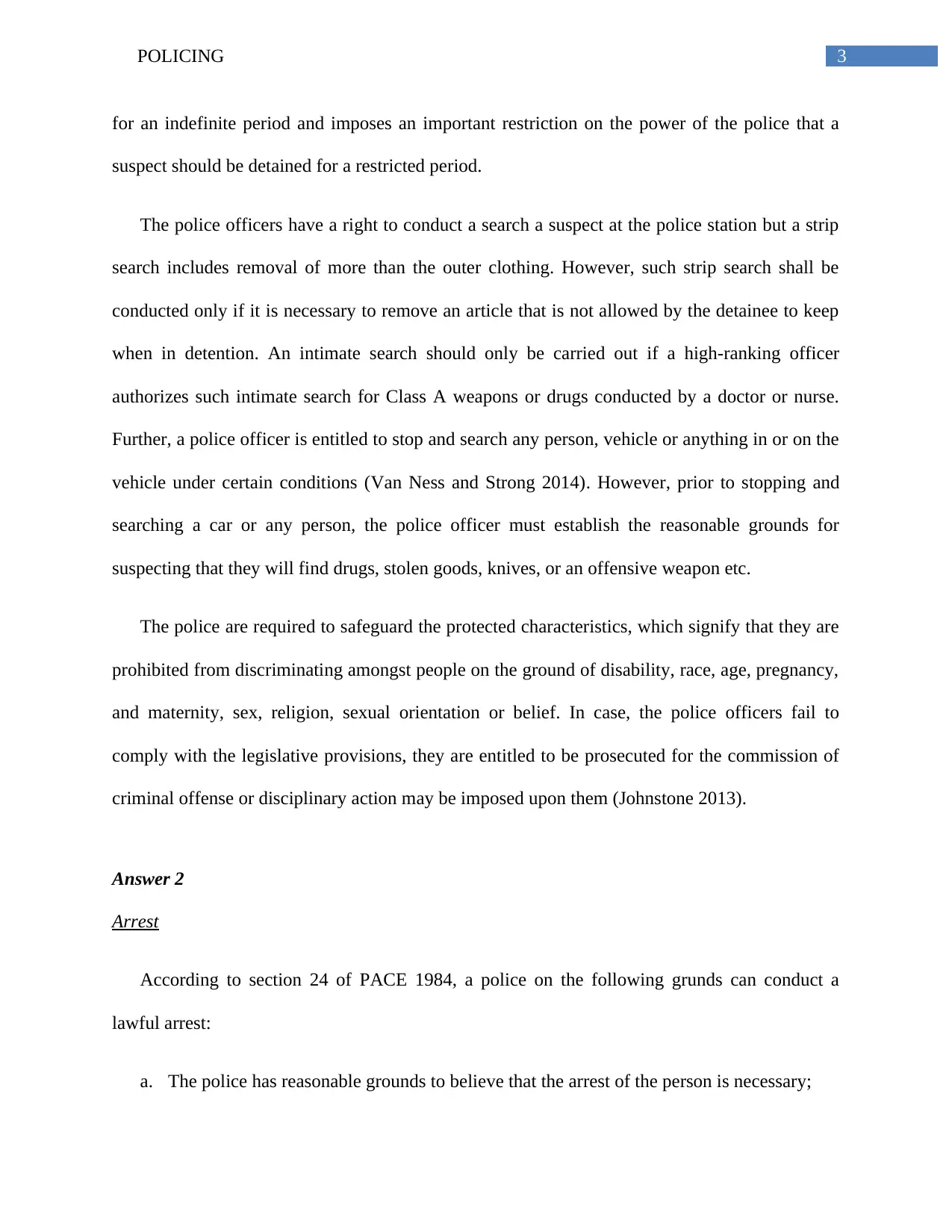
3POLICING
for an indefinite period and imposes an important restriction on the power of the police that a
suspect should be detained for a restricted period.
The police officers have a right to conduct a search a suspect at the police station but a strip
search includes removal of more than the outer clothing. However, such strip search shall be
conducted only if it is necessary to remove an article that is not allowed by the detainee to keep
when in detention. An intimate search should only be carried out if a high-ranking officer
authorizes such intimate search for Class A weapons or drugs conducted by a doctor or nurse.
Further, a police officer is entitled to stop and search any person, vehicle or anything in or on the
vehicle under certain conditions (Van Ness and Strong 2014). However, prior to stopping and
searching a car or any person, the police officer must establish the reasonable grounds for
suspecting that they will find drugs, stolen goods, knives, or an offensive weapon etc.
The police are required to safeguard the protected characteristics, which signify that they are
prohibited from discriminating amongst people on the ground of disability, race, age, pregnancy,
and maternity, sex, religion, sexual orientation or belief. In case, the police officers fail to
comply with the legislative provisions, they are entitled to be prosecuted for the commission of
criminal offense or disciplinary action may be imposed upon them (Johnstone 2013).
Answer 2
Arrest
According to section 24 of PACE 1984, a police on the following grunds can conduct a
lawful arrest:
a. The police has reasonable grounds to believe that the arrest of the person is necessary;
for an indefinite period and imposes an important restriction on the power of the police that a
suspect should be detained for a restricted period.
The police officers have a right to conduct a search a suspect at the police station but a strip
search includes removal of more than the outer clothing. However, such strip search shall be
conducted only if it is necessary to remove an article that is not allowed by the detainee to keep
when in detention. An intimate search should only be carried out if a high-ranking officer
authorizes such intimate search for Class A weapons or drugs conducted by a doctor or nurse.
Further, a police officer is entitled to stop and search any person, vehicle or anything in or on the
vehicle under certain conditions (Van Ness and Strong 2014). However, prior to stopping and
searching a car or any person, the police officer must establish the reasonable grounds for
suspecting that they will find drugs, stolen goods, knives, or an offensive weapon etc.
The police are required to safeguard the protected characteristics, which signify that they are
prohibited from discriminating amongst people on the ground of disability, race, age, pregnancy,
and maternity, sex, religion, sexual orientation or belief. In case, the police officers fail to
comply with the legislative provisions, they are entitled to be prosecuted for the commission of
criminal offense or disciplinary action may be imposed upon them (Johnstone 2013).
Answer 2
Arrest
According to section 24 of PACE 1984, a police on the following grunds can conduct a
lawful arrest:
a. The police has reasonable grounds to believe that the arrest of the person is necessary;
Paraphrase This Document
Need a fresh take? Get an instant paraphrase of this document with our AI Paraphraser
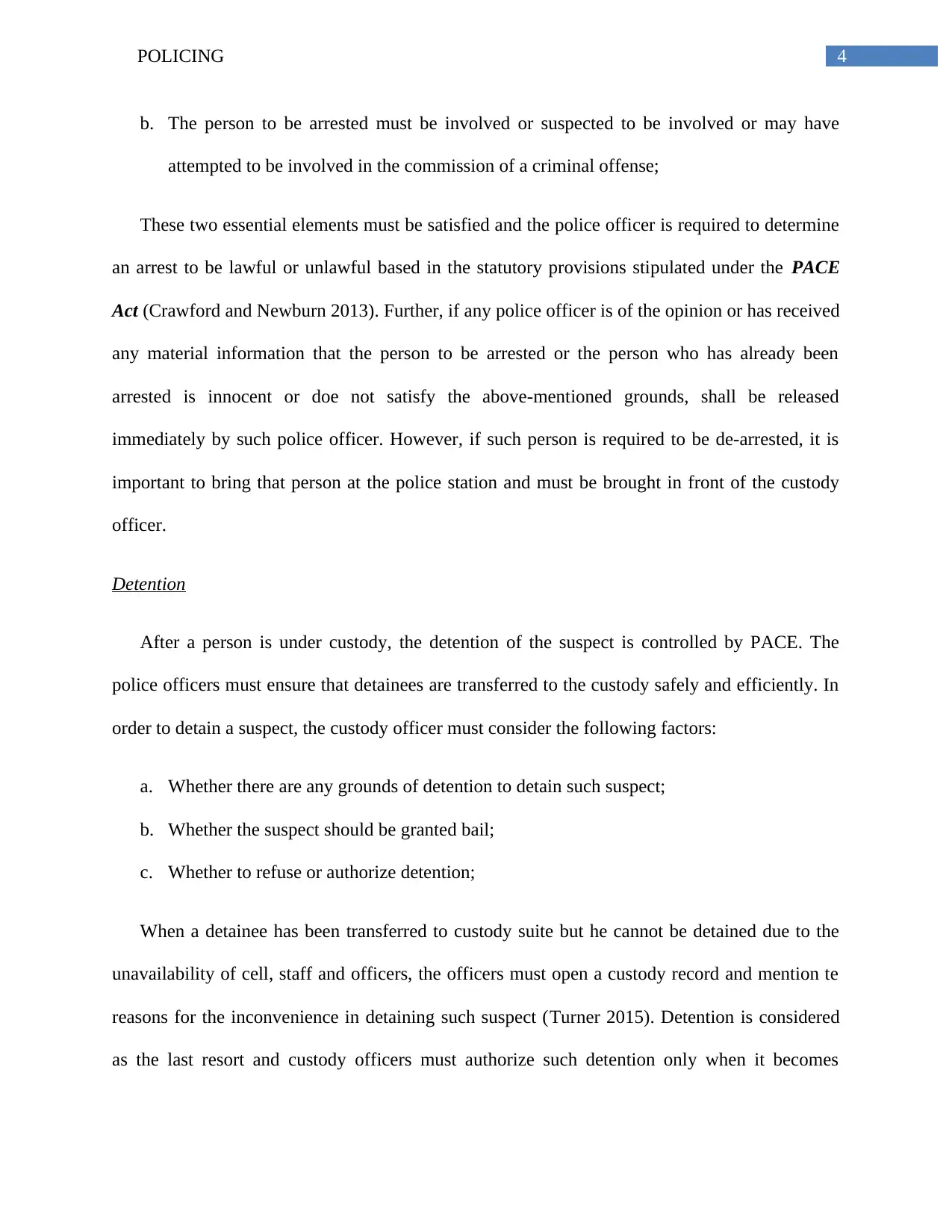
4POLICING
b. The person to be arrested must be involved or suspected to be involved or may have
attempted to be involved in the commission of a criminal offense;
These two essential elements must be satisfied and the police officer is required to determine
an arrest to be lawful or unlawful based in the statutory provisions stipulated under the PACE
Act (Crawford and Newburn 2013). Further, if any police officer is of the opinion or has received
any material information that the person to be arrested or the person who has already been
arrested is innocent or doe not satisfy the above-mentioned grounds, shall be released
immediately by such police officer. However, if such person is required to be de-arrested, it is
important to bring that person at the police station and must be brought in front of the custody
officer.
Detention
After a person is under custody, the detention of the suspect is controlled by PACE. The
police officers must ensure that detainees are transferred to the custody safely and efficiently. In
order to detain a suspect, the custody officer must consider the following factors:
a. Whether there are any grounds of detention to detain such suspect;
b. Whether the suspect should be granted bail;
c. Whether to refuse or authorize detention;
When a detainee has been transferred to custody suite but he cannot be detained due to the
unavailability of cell, staff and officers, the officers must open a custody record and mention te
reasons for the inconvenience in detaining such suspect (Turner 2015). Detention is considered
as the last resort and custody officers must authorize such detention only when it becomes
b. The person to be arrested must be involved or suspected to be involved or may have
attempted to be involved in the commission of a criminal offense;
These two essential elements must be satisfied and the police officer is required to determine
an arrest to be lawful or unlawful based in the statutory provisions stipulated under the PACE
Act (Crawford and Newburn 2013). Further, if any police officer is of the opinion or has received
any material information that the person to be arrested or the person who has already been
arrested is innocent or doe not satisfy the above-mentioned grounds, shall be released
immediately by such police officer. However, if such person is required to be de-arrested, it is
important to bring that person at the police station and must be brought in front of the custody
officer.
Detention
After a person is under custody, the detention of the suspect is controlled by PACE. The
police officers must ensure that detainees are transferred to the custody safely and efficiently. In
order to detain a suspect, the custody officer must consider the following factors:
a. Whether there are any grounds of detention to detain such suspect;
b. Whether the suspect should be granted bail;
c. Whether to refuse or authorize detention;
When a detainee has been transferred to custody suite but he cannot be detained due to the
unavailability of cell, staff and officers, the officers must open a custody record and mention te
reasons for the inconvenience in detaining such suspect (Turner 2015). Detention is considered
as the last resort and custody officers must authorize such detention only when it becomes
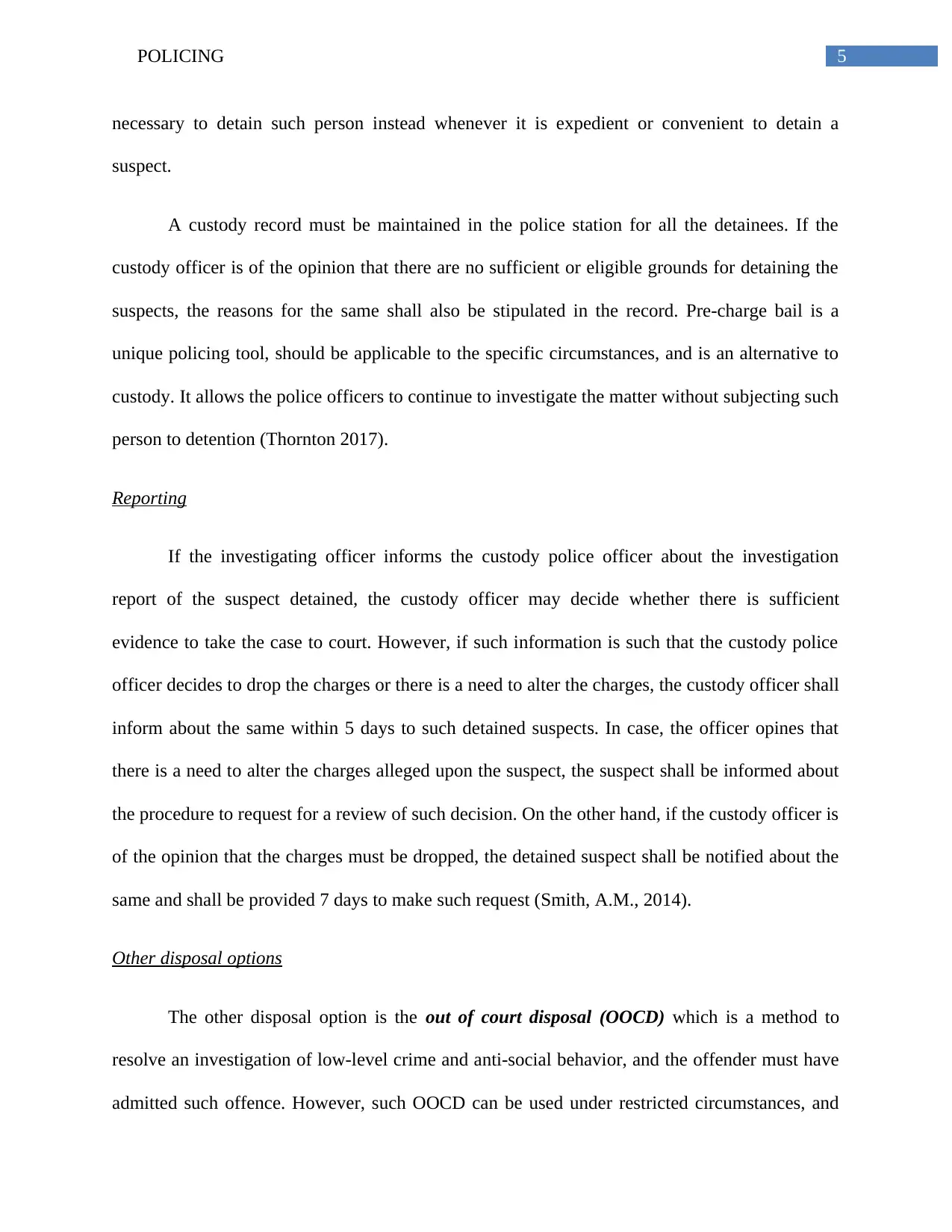
5POLICING
necessary to detain such person instead whenever it is expedient or convenient to detain a
suspect.
A custody record must be maintained in the police station for all the detainees. If the
custody officer is of the opinion that there are no sufficient or eligible grounds for detaining the
suspects, the reasons for the same shall also be stipulated in the record. Pre-charge bail is a
unique policing tool, should be applicable to the specific circumstances, and is an alternative to
custody. It allows the police officers to continue to investigate the matter without subjecting such
person to detention (Thornton 2017).
Reporting
If the investigating officer informs the custody police officer about the investigation
report of the suspect detained, the custody officer may decide whether there is sufficient
evidence to take the case to court. However, if such information is such that the custody police
officer decides to drop the charges or there is a need to alter the charges, the custody officer shall
inform about the same within 5 days to such detained suspects. In case, the officer opines that
there is a need to alter the charges alleged upon the suspect, the suspect shall be informed about
the procedure to request for a review of such decision. On the other hand, if the custody officer is
of the opinion that the charges must be dropped, the detained suspect shall be notified about the
same and shall be provided 7 days to make such request (Smith, A.M., 2014).
Other disposal options
The other disposal option is the out of court disposal (OOCD) which is a method to
resolve an investigation of low-level crime and anti-social behavior, and the offender must have
admitted such offence. However, such OOCD can be used under restricted circumstances, and
necessary to detain such person instead whenever it is expedient or convenient to detain a
suspect.
A custody record must be maintained in the police station for all the detainees. If the
custody officer is of the opinion that there are no sufficient or eligible grounds for detaining the
suspects, the reasons for the same shall also be stipulated in the record. Pre-charge bail is a
unique policing tool, should be applicable to the specific circumstances, and is an alternative to
custody. It allows the police officers to continue to investigate the matter without subjecting such
person to detention (Thornton 2017).
Reporting
If the investigating officer informs the custody police officer about the investigation
report of the suspect detained, the custody officer may decide whether there is sufficient
evidence to take the case to court. However, if such information is such that the custody police
officer decides to drop the charges or there is a need to alter the charges, the custody officer shall
inform about the same within 5 days to such detained suspects. In case, the officer opines that
there is a need to alter the charges alleged upon the suspect, the suspect shall be informed about
the procedure to request for a review of such decision. On the other hand, if the custody officer is
of the opinion that the charges must be dropped, the detained suspect shall be notified about the
same and shall be provided 7 days to make such request (Smith, A.M., 2014).
Other disposal options
The other disposal option is the out of court disposal (OOCD) which is a method to
resolve an investigation of low-level crime and anti-social behavior, and the offender must have
admitted such offence. However, such OOCD can be used under restricted circumstances, and
⊘ This is a preview!⊘
Do you want full access?
Subscribe today to unlock all pages.

Trusted by 1+ million students worldwide
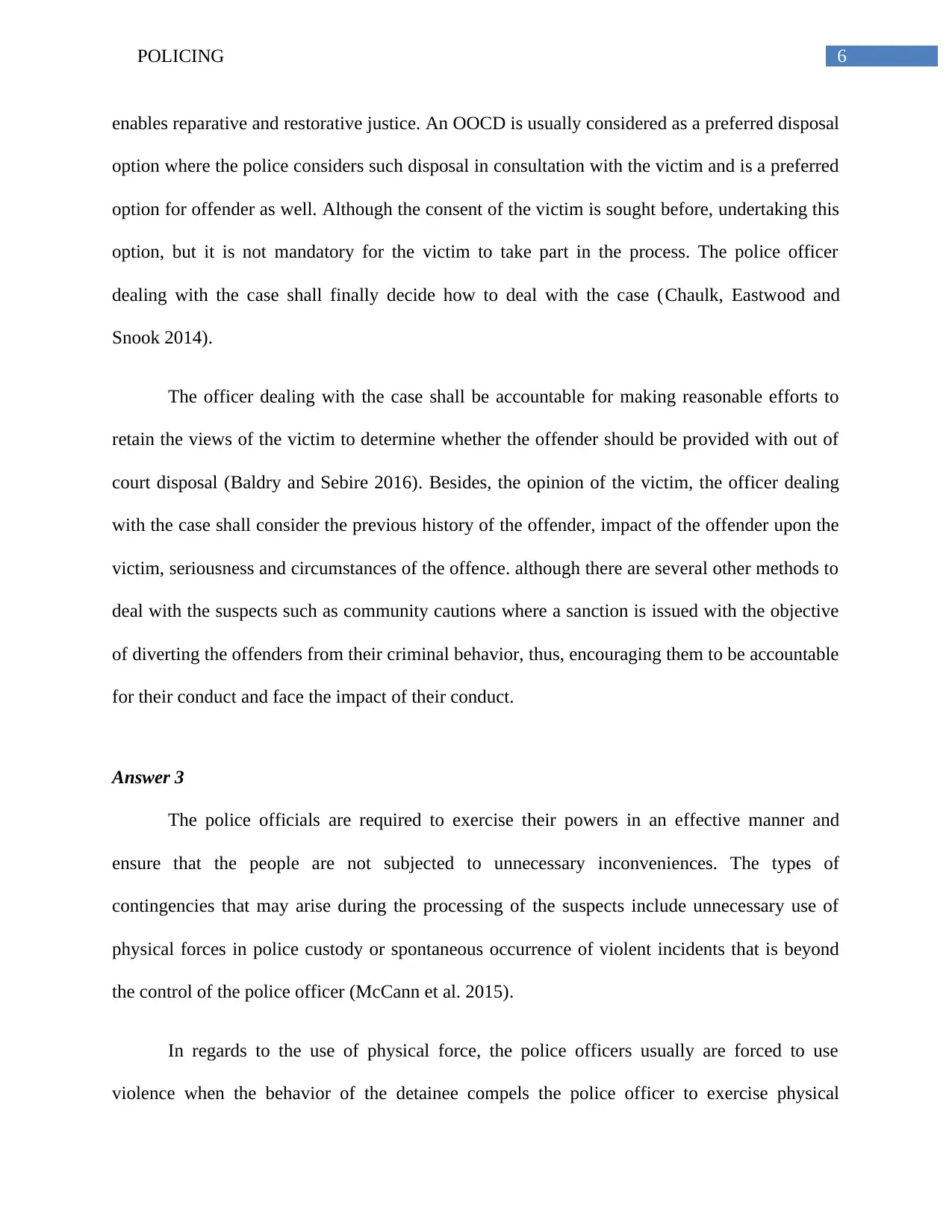
6POLICING
enables reparative and restorative justice. An OOCD is usually considered as a preferred disposal
option where the police considers such disposal in consultation with the victim and is a preferred
option for offender as well. Although the consent of the victim is sought before, undertaking this
option, but it is not mandatory for the victim to take part in the process. The police officer
dealing with the case shall finally decide how to deal with the case (Chaulk, Eastwood and
Snook 2014).
The officer dealing with the case shall be accountable for making reasonable efforts to
retain the views of the victim to determine whether the offender should be provided with out of
court disposal (Baldry and Sebire 2016). Besides, the opinion of the victim, the officer dealing
with the case shall consider the previous history of the offender, impact of the offender upon the
victim, seriousness and circumstances of the offence. although there are several other methods to
deal with the suspects such as community cautions where a sanction is issued with the objective
of diverting the offenders from their criminal behavior, thus, encouraging them to be accountable
for their conduct and face the impact of their conduct.
Answer 3
The police officials are required to exercise their powers in an effective manner and
ensure that the people are not subjected to unnecessary inconveniences. The types of
contingencies that may arise during the processing of the suspects include unnecessary use of
physical forces in police custody or spontaneous occurrence of violent incidents that is beyond
the control of the police officer (McCann et al. 2015).
In regards to the use of physical force, the police officers usually are forced to use
violence when the behavior of the detainee compels the police officer to exercise physical
enables reparative and restorative justice. An OOCD is usually considered as a preferred disposal
option where the police considers such disposal in consultation with the victim and is a preferred
option for offender as well. Although the consent of the victim is sought before, undertaking this
option, but it is not mandatory for the victim to take part in the process. The police officer
dealing with the case shall finally decide how to deal with the case (Chaulk, Eastwood and
Snook 2014).
The officer dealing with the case shall be accountable for making reasonable efforts to
retain the views of the victim to determine whether the offender should be provided with out of
court disposal (Baldry and Sebire 2016). Besides, the opinion of the victim, the officer dealing
with the case shall consider the previous history of the offender, impact of the offender upon the
victim, seriousness and circumstances of the offence. although there are several other methods to
deal with the suspects such as community cautions where a sanction is issued with the objective
of diverting the offenders from their criminal behavior, thus, encouraging them to be accountable
for their conduct and face the impact of their conduct.
Answer 3
The police officials are required to exercise their powers in an effective manner and
ensure that the people are not subjected to unnecessary inconveniences. The types of
contingencies that may arise during the processing of the suspects include unnecessary use of
physical forces in police custody or spontaneous occurrence of violent incidents that is beyond
the control of the police officer (McCann et al. 2015).
In regards to the use of physical force, the police officers usually are forced to use
violence when the behavior of the detainee compels the police officer to exercise physical
Paraphrase This Document
Need a fresh take? Get an instant paraphrase of this document with our AI Paraphraser
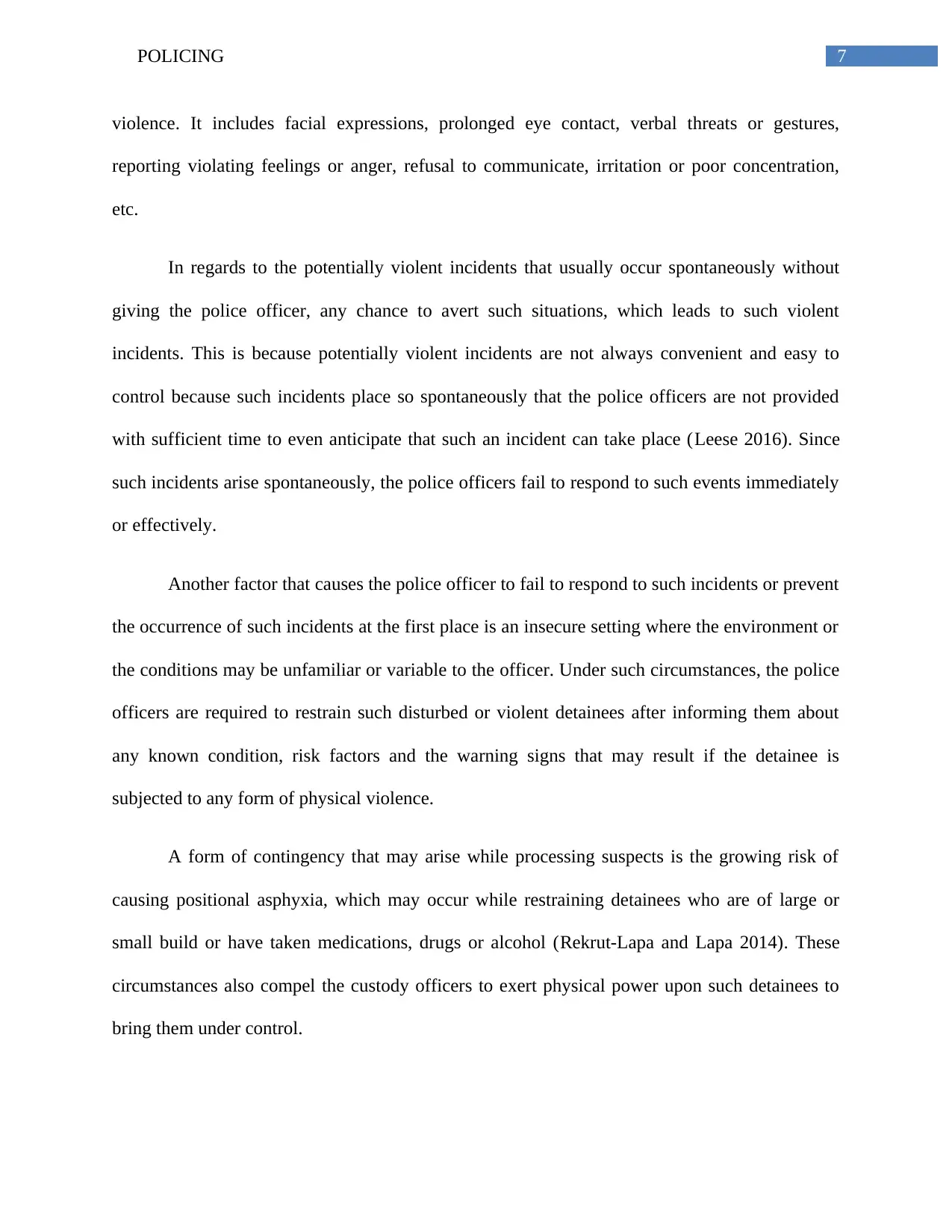
7POLICING
violence. It includes facial expressions, prolonged eye contact, verbal threats or gestures,
reporting violating feelings or anger, refusal to communicate, irritation or poor concentration,
etc.
In regards to the potentially violent incidents that usually occur spontaneously without
giving the police officer, any chance to avert such situations, which leads to such violent
incidents. This is because potentially violent incidents are not always convenient and easy to
control because such incidents place so spontaneously that the police officers are not provided
with sufficient time to even anticipate that such an incident can take place (Leese 2016). Since
such incidents arise spontaneously, the police officers fail to respond to such events immediately
or effectively.
Another factor that causes the police officer to fail to respond to such incidents or prevent
the occurrence of such incidents at the first place is an insecure setting where the environment or
the conditions may be unfamiliar or variable to the officer. Under such circumstances, the police
officers are required to restrain such disturbed or violent detainees after informing them about
any known condition, risk factors and the warning signs that may result if the detainee is
subjected to any form of physical violence.
A form of contingency that may arise while processing suspects is the growing risk of
causing positional asphyxia, which may occur while restraining detainees who are of large or
small build or have taken medications, drugs or alcohol (Rekrut-Lapa and Lapa 2014). These
circumstances also compel the custody officers to exert physical power upon such detainees to
bring them under control.
violence. It includes facial expressions, prolonged eye contact, verbal threats or gestures,
reporting violating feelings or anger, refusal to communicate, irritation or poor concentration,
etc.
In regards to the potentially violent incidents that usually occur spontaneously without
giving the police officer, any chance to avert such situations, which leads to such violent
incidents. This is because potentially violent incidents are not always convenient and easy to
control because such incidents place so spontaneously that the police officers are not provided
with sufficient time to even anticipate that such an incident can take place (Leese 2016). Since
such incidents arise spontaneously, the police officers fail to respond to such events immediately
or effectively.
Another factor that causes the police officer to fail to respond to such incidents or prevent
the occurrence of such incidents at the first place is an insecure setting where the environment or
the conditions may be unfamiliar or variable to the officer. Under such circumstances, the police
officers are required to restrain such disturbed or violent detainees after informing them about
any known condition, risk factors and the warning signs that may result if the detainee is
subjected to any form of physical violence.
A form of contingency that may arise while processing suspects is the growing risk of
causing positional asphyxia, which may occur while restraining detainees who are of large or
small build or have taken medications, drugs or alcohol (Rekrut-Lapa and Lapa 2014). These
circumstances also compel the custody officers to exert physical power upon such detainees to
bring them under control.
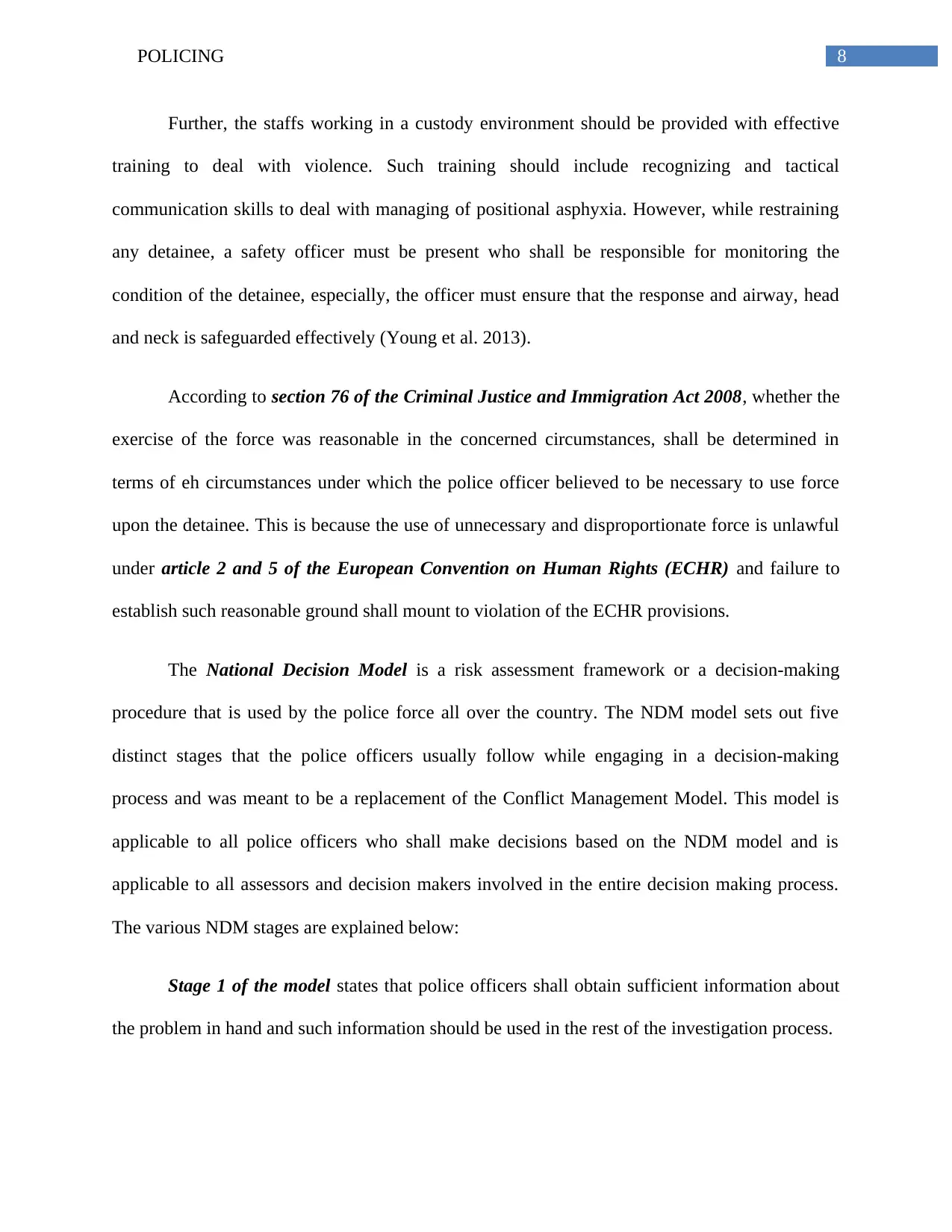
8POLICING
Further, the staffs working in a custody environment should be provided with effective
training to deal with violence. Such training should include recognizing and tactical
communication skills to deal with managing of positional asphyxia. However, while restraining
any detainee, a safety officer must be present who shall be responsible for monitoring the
condition of the detainee, especially, the officer must ensure that the response and airway, head
and neck is safeguarded effectively (Young et al. 2013).
According to section 76 of the Criminal Justice and Immigration Act 2008, whether the
exercise of the force was reasonable in the concerned circumstances, shall be determined in
terms of eh circumstances under which the police officer believed to be necessary to use force
upon the detainee. This is because the use of unnecessary and disproportionate force is unlawful
under article 2 and 5 of the European Convention on Human Rights (ECHR) and failure to
establish such reasonable ground shall mount to violation of the ECHR provisions.
The National Decision Model is a risk assessment framework or a decision-making
procedure that is used by the police force all over the country. The NDM model sets out five
distinct stages that the police officers usually follow while engaging in a decision-making
process and was meant to be a replacement of the Conflict Management Model. This model is
applicable to all police officers who shall make decisions based on the NDM model and is
applicable to all assessors and decision makers involved in the entire decision making process.
The various NDM stages are explained below:
Stage 1 of the model states that police officers shall obtain sufficient information about
the problem in hand and such information should be used in the rest of the investigation process.
Further, the staffs working in a custody environment should be provided with effective
training to deal with violence. Such training should include recognizing and tactical
communication skills to deal with managing of positional asphyxia. However, while restraining
any detainee, a safety officer must be present who shall be responsible for monitoring the
condition of the detainee, especially, the officer must ensure that the response and airway, head
and neck is safeguarded effectively (Young et al. 2013).
According to section 76 of the Criminal Justice and Immigration Act 2008, whether the
exercise of the force was reasonable in the concerned circumstances, shall be determined in
terms of eh circumstances under which the police officer believed to be necessary to use force
upon the detainee. This is because the use of unnecessary and disproportionate force is unlawful
under article 2 and 5 of the European Convention on Human Rights (ECHR) and failure to
establish such reasonable ground shall mount to violation of the ECHR provisions.
The National Decision Model is a risk assessment framework or a decision-making
procedure that is used by the police force all over the country. The NDM model sets out five
distinct stages that the police officers usually follow while engaging in a decision-making
process and was meant to be a replacement of the Conflict Management Model. This model is
applicable to all police officers who shall make decisions based on the NDM model and is
applicable to all assessors and decision makers involved in the entire decision making process.
The various NDM stages are explained below:
Stage 1 of the model states that police officers shall obtain sufficient information about
the problem in hand and such information should be used in the rest of the investigation process.
⊘ This is a preview!⊘
Do you want full access?
Subscribe today to unlock all pages.

Trusted by 1+ million students worldwide
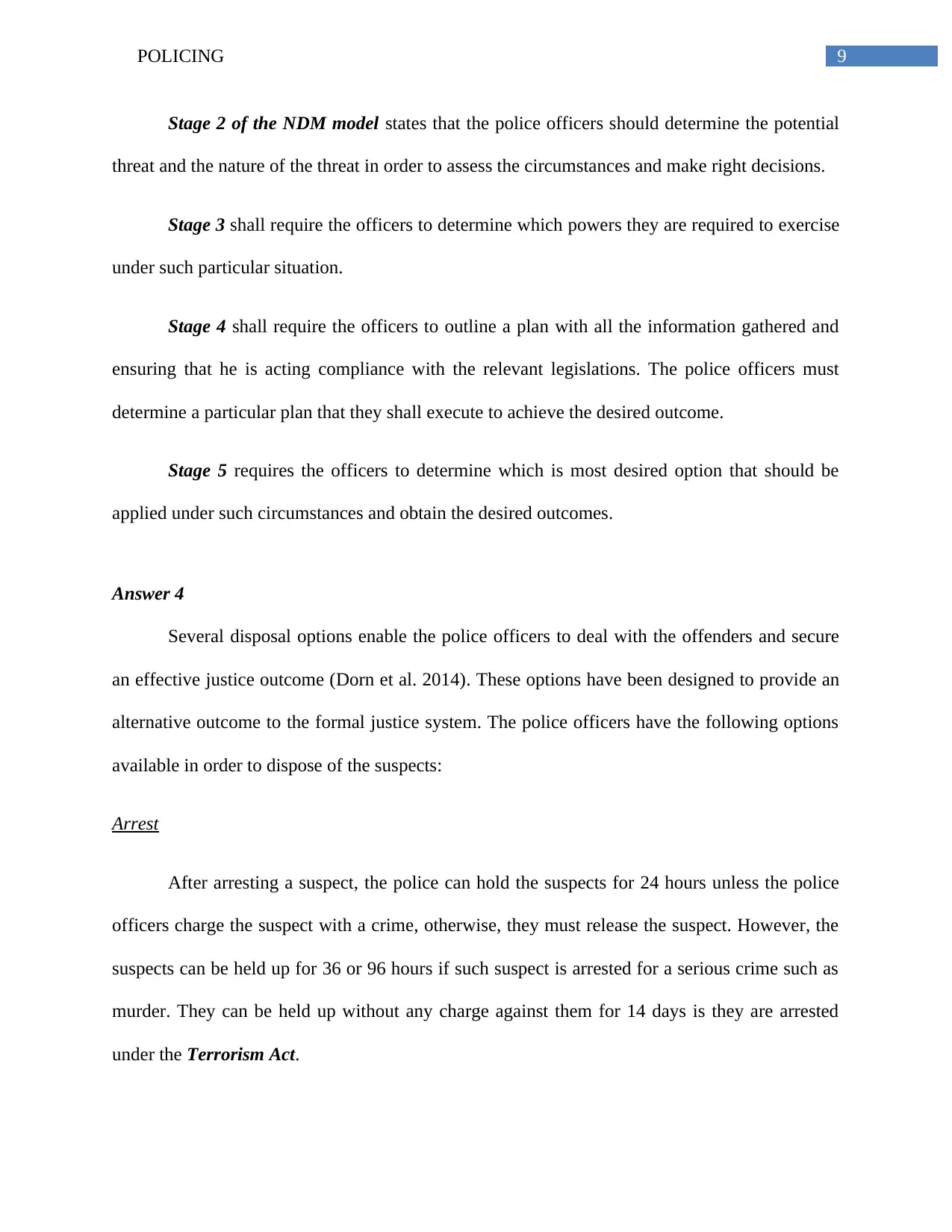
9POLICING
Stage 2 of the NDM model states that the police officers should determine the potential
threat and the nature of the threat in order to assess the circumstances and make right decisions.
Stage 3 shall require the officers to determine which powers they are required to exercise
under such particular situation.
Stage 4 shall require the officers to outline a plan with all the information gathered and
ensuring that he is acting compliance with the relevant legislations. The police officers must
determine a particular plan that they shall execute to achieve the desired outcome.
Stage 5 requires the officers to determine which is most desired option that should be
applied under such circumstances and obtain the desired outcomes.
Answer 4
Several disposal options enable the police officers to deal with the offenders and secure
an effective justice outcome (Dorn et al. 2014). These options have been designed to provide an
alternative outcome to the formal justice system. The police officers have the following options
available in order to dispose of the suspects:
Arrest
After arresting a suspect, the police can hold the suspects for 24 hours unless the police
officers charge the suspect with a crime, otherwise, they must release the suspect. However, the
suspects can be held up for 36 or 96 hours if such suspect is arrested for a serious crime such as
murder. They can be held up without any charge against them for 14 days is they are arrested
under the Terrorism Act.
Stage 2 of the NDM model states that the police officers should determine the potential
threat and the nature of the threat in order to assess the circumstances and make right decisions.
Stage 3 shall require the officers to determine which powers they are required to exercise
under such particular situation.
Stage 4 shall require the officers to outline a plan with all the information gathered and
ensuring that he is acting compliance with the relevant legislations. The police officers must
determine a particular plan that they shall execute to achieve the desired outcome.
Stage 5 requires the officers to determine which is most desired option that should be
applied under such circumstances and obtain the desired outcomes.
Answer 4
Several disposal options enable the police officers to deal with the offenders and secure
an effective justice outcome (Dorn et al. 2014). These options have been designed to provide an
alternative outcome to the formal justice system. The police officers have the following options
available in order to dispose of the suspects:
Arrest
After arresting a suspect, the police can hold the suspects for 24 hours unless the police
officers charge the suspect with a crime, otherwise, they must release the suspect. However, the
suspects can be held up for 36 or 96 hours if such suspect is arrested for a serious crime such as
murder. They can be held up without any charge against them for 14 days is they are arrested
under the Terrorism Act.
Paraphrase This Document
Need a fresh take? Get an instant paraphrase of this document with our AI Paraphraser
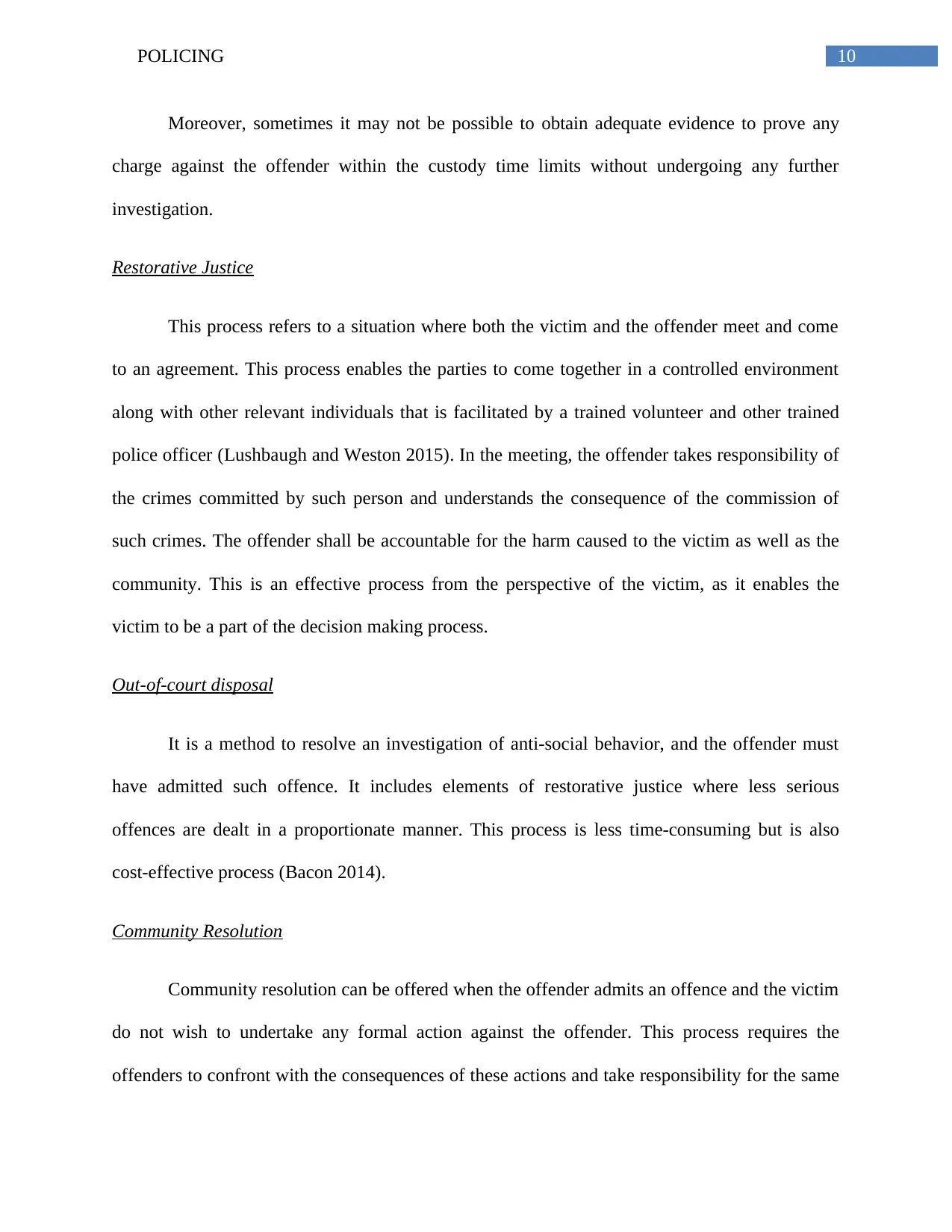
10POLICING
Moreover, sometimes it may not be possible to obtain adequate evidence to prove any
charge against the offender within the custody time limits without undergoing any further
investigation.
Restorative Justice
This process refers to a situation where both the victim and the offender meet and come
to an agreement. This process enables the parties to come together in a controlled environment
along with other relevant individuals that is facilitated by a trained volunteer and other trained
police officer (Lushbaugh and Weston 2015). In the meeting, the offender takes responsibility of
the crimes committed by such person and understands the consequence of the commission of
such crimes. The offender shall be accountable for the harm caused to the victim as well as the
community. This is an effective process from the perspective of the victim, as it enables the
victim to be a part of the decision making process.
Out-of-court disposal
It is a method to resolve an investigation of anti-social behavior, and the offender must
have admitted such offence. It includes elements of restorative justice where less serious
offences are dealt in a proportionate manner. This process is less time-consuming but is also
cost-effective process (Bacon 2014).
Community Resolution
Community resolution can be offered when the offender admits an offence and the victim
do not wish to undertake any formal action against the offender. This process requires the
offenders to confront with the consequences of these actions and take responsibility for the same
Moreover, sometimes it may not be possible to obtain adequate evidence to prove any
charge against the offender within the custody time limits without undergoing any further
investigation.
Restorative Justice
This process refers to a situation where both the victim and the offender meet and come
to an agreement. This process enables the parties to come together in a controlled environment
along with other relevant individuals that is facilitated by a trained volunteer and other trained
police officer (Lushbaugh and Weston 2015). In the meeting, the offender takes responsibility of
the crimes committed by such person and understands the consequence of the commission of
such crimes. The offender shall be accountable for the harm caused to the victim as well as the
community. This is an effective process from the perspective of the victim, as it enables the
victim to be a part of the decision making process.
Out-of-court disposal
It is a method to resolve an investigation of anti-social behavior, and the offender must
have admitted such offence. It includes elements of restorative justice where less serious
offences are dealt in a proportionate manner. This process is less time-consuming but is also
cost-effective process (Bacon 2014).
Community Resolution
Community resolution can be offered when the offender admits an offence and the victim
do not wish to undertake any formal action against the offender. This process requires the
offenders to confront with the consequences of these actions and take responsibility for the same
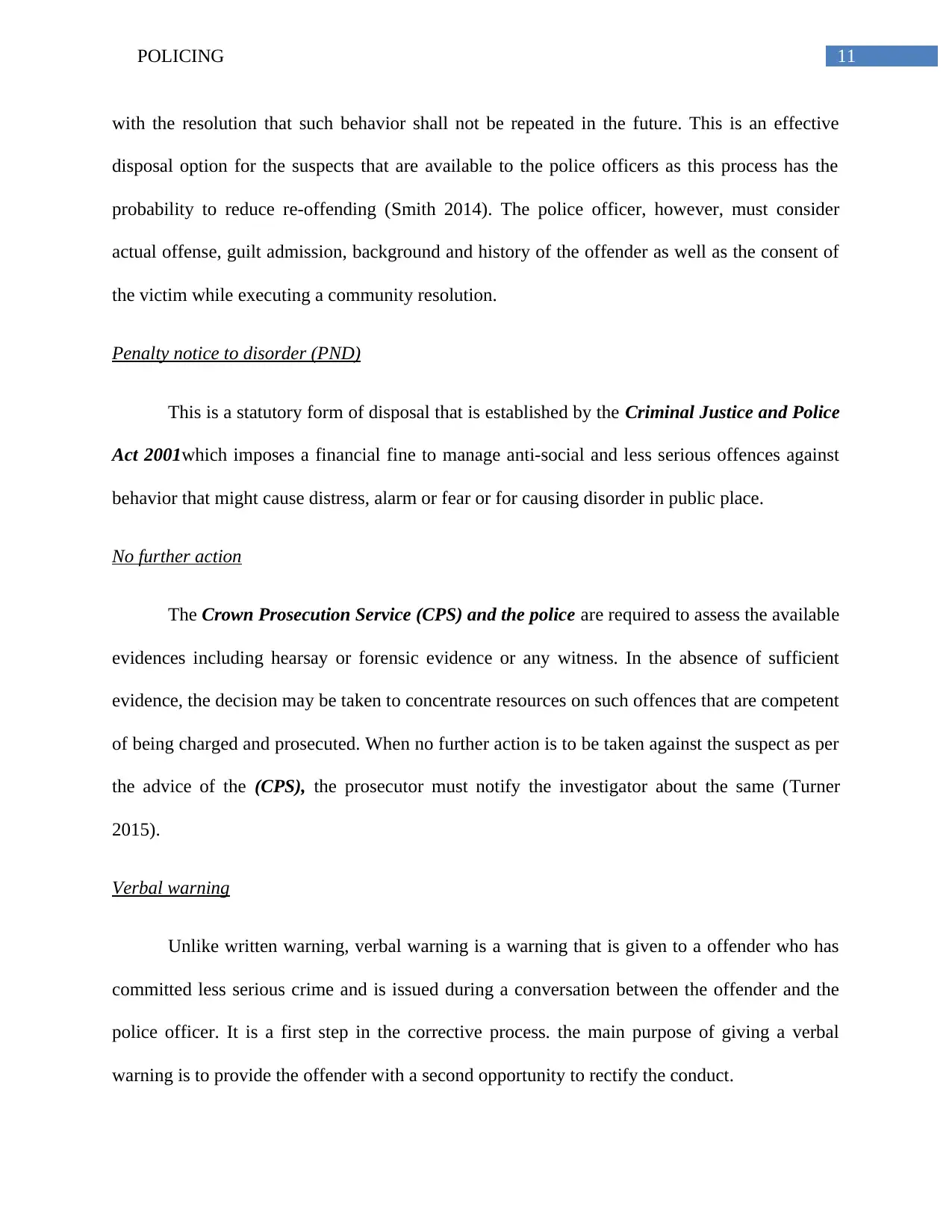
11POLICING
with the resolution that such behavior shall not be repeated in the future. This is an effective
disposal option for the suspects that are available to the police officers as this process has the
probability to reduce re-offending (Smith 2014). The police officer, however, must consider
actual offense, guilt admission, background and history of the offender as well as the consent of
the victim while executing a community resolution.
Penalty notice to disorder (PND)
This is a statutory form of disposal that is established by the Criminal Justice and Police
Act 2001which imposes a financial fine to manage anti-social and less serious offences against
behavior that might cause distress, alarm or fear or for causing disorder in public place.
No further action
The Crown Prosecution Service (CPS) and the police are required to assess the available
evidences including hearsay or forensic evidence or any witness. In the absence of sufficient
evidence, the decision may be taken to concentrate resources on such offences that are competent
of being charged and prosecuted. When no further action is to be taken against the suspect as per
the advice of the (CPS), the prosecutor must notify the investigator about the same (Turner
2015).
Verbal warning
Unlike written warning, verbal warning is a warning that is given to a offender who has
committed less serious crime and is issued during a conversation between the offender and the
police officer. It is a first step in the corrective process. the main purpose of giving a verbal
warning is to provide the offender with a second opportunity to rectify the conduct.
with the resolution that such behavior shall not be repeated in the future. This is an effective
disposal option for the suspects that are available to the police officers as this process has the
probability to reduce re-offending (Smith 2014). The police officer, however, must consider
actual offense, guilt admission, background and history of the offender as well as the consent of
the victim while executing a community resolution.
Penalty notice to disorder (PND)
This is a statutory form of disposal that is established by the Criminal Justice and Police
Act 2001which imposes a financial fine to manage anti-social and less serious offences against
behavior that might cause distress, alarm or fear or for causing disorder in public place.
No further action
The Crown Prosecution Service (CPS) and the police are required to assess the available
evidences including hearsay or forensic evidence or any witness. In the absence of sufficient
evidence, the decision may be taken to concentrate resources on such offences that are competent
of being charged and prosecuted. When no further action is to be taken against the suspect as per
the advice of the (CPS), the prosecutor must notify the investigator about the same (Turner
2015).
Verbal warning
Unlike written warning, verbal warning is a warning that is given to a offender who has
committed less serious crime and is issued during a conversation between the offender and the
police officer. It is a first step in the corrective process. the main purpose of giving a verbal
warning is to provide the offender with a second opportunity to rectify the conduct.
⊘ This is a preview!⊘
Do you want full access?
Subscribe today to unlock all pages.

Trusted by 1+ million students worldwide
1 out of 16
Related Documents
Your All-in-One AI-Powered Toolkit for Academic Success.
+13062052269
info@desklib.com
Available 24*7 on WhatsApp / Email
![[object Object]](/_next/static/media/star-bottom.7253800d.svg)
Unlock your academic potential
Copyright © 2020–2025 A2Z Services. All Rights Reserved. Developed and managed by ZUCOL.





